Temperature affects children’s health by influencing their immune response, increasing vulnerability to heat-related illnesses, and exacerbating respiratory conditions.
Children face unique health risks from temperature extremes. Their developing bodies react differently to heat and cold than adults, making them more vulnerable to climate-related illnesses. Understanding these risks helps parents and caregivers protect kids year-round.

Why Children Are More Vulnerable to Temperature Changes
Several physiological factors make children particularly sensitive to temperature fluctuations:
- Higher metabolic rates generate more internal heat
- Smaller body mass heats up and cools down faster
- Underdeveloped sweat glands reduce cooling capacity
- Greater skin surface area relative to body weight
Heat Risks for Different Age Groups
Infants (0-1 year)
Babies can’t regulate body temperature effectively. Their bodies absorb more heat from the environment while having limited ability to cool down. Heat stress in infants can lead to:
- Dehydration
- Heat rash
- Heat exhaustion
- Increased risk of SIDS
Toddlers (1-3 years)
Active toddlers often ignore thirst cues during play. They’re prone to:
- Heat cramps
- Fainting spells
- Sunburn
School-Age Children
Older children face risks during outdoor activities and sports:
- Heat stroke (life-threatening)
- Exercise-induced dehydration
- Worsening asthma symptoms

Cold Weather Health Threats
Extreme cold presents different challenges for children’s health:
| Condition | Symptoms | Prevention |
|---|---|---|
| Hypothermia | Shivering, drowsiness, slurred speech | Layered clothing, limit outdoor time |
| Frostbite | White/gray skin, numbness, blisters | Protect extremities, dry clothing |
| Respiratory infections | Coughing, fever, congestion | Vaccinations, hand washing |
Indoor Heating Considerations
Proper home heating is essential for child safety in cold weather. Consider radiator-style heaters for consistent warmth without drying the air excessively. Avoid space heaters in children’s rooms due to burn and fire risks.
Climate Change and Growing Risks
According to UNICEF research, climate change is increasing heat wave frequency and intensity. By 2050, nearly every child worldwide will face frequent heat exposure.
Long-Term Health Consequences
Repeated temperature extremes can lead to chronic health issues:
- Increased asthma and allergy development
- Higher risk of kidney disease
- Nutritional deficiencies from crop failures
- Mental health impacts from disrupted routines
Protecting Children from Temperature Extremes
Heat Safety Measures
- Schedule outdoor activities for cooler morning/evening hours
- Provide water every 15-20 minutes during play
- Use light-colored, loose-fitting clothing
- Create cool zones with shade or air conditioning
Cold Weather Protection
- Dress in layers (base layer, insulation, wind/waterproof outer)
- Change wet clothing immediately
- Use safe heating alternatives that don’t produce carbon monoxide
- Monitor for shivering or complaints of numbness
Recognizing Temperature-Related Illness
Early detection prevents serious complications. Watch for these warning signs:
Heat Exhaustion
- Pale, clammy skin
- Headache and dizziness
- Nausea or vomiting
- Rapid, weak pulse
Heat Stroke (Medical Emergency)
- Hot, red, dry skin
- Confusion or loss of consciousness
- Body temperature above 103°F (39.4°C)
According to the EPA, climate-related health impacts on children require urgent attention from families and policymakers alike.
School and Community Considerations
Educational settings need temperature management plans:
- Heat-smart physical education policies
- Air quality monitoring for indoor activities
- Emergency cooling centers during heat waves
- Cold weather recess guidelines
